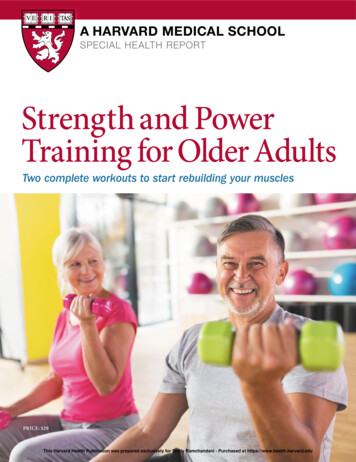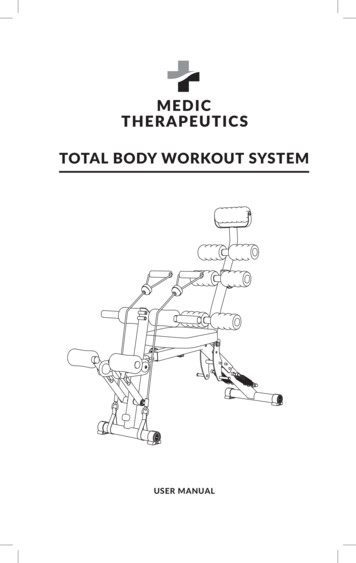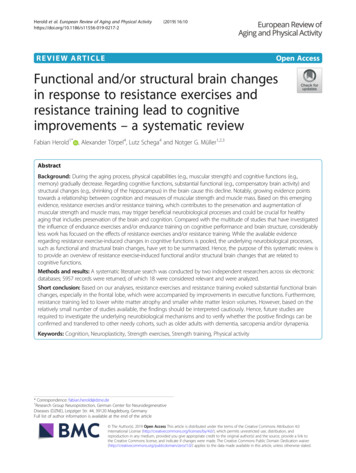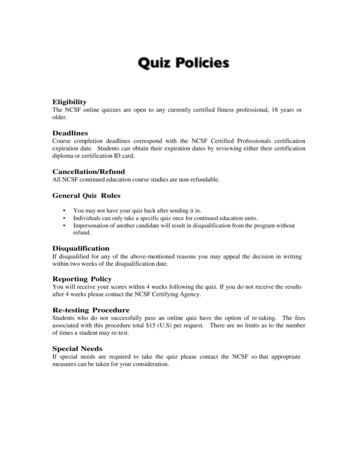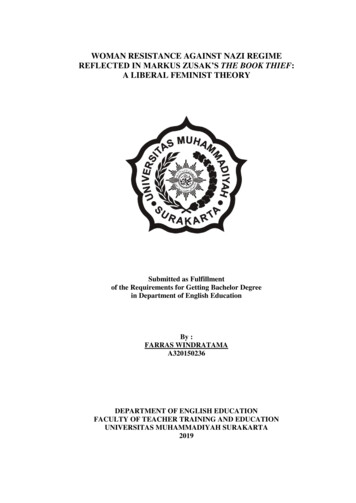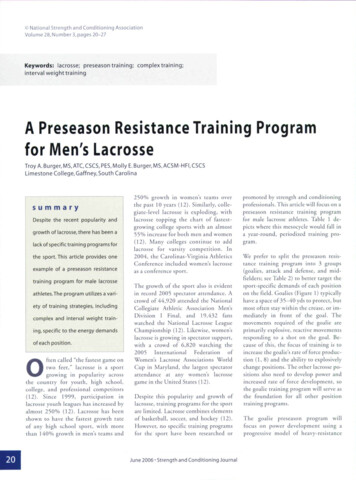
Transcription
National Strength and Conditioning AssociationVolume 28, Number 3, pages 20-27Keywords: lacrosse; preseason training; complex training;interval weight trainingA Preseason Resistance Training Programfor Men's LacrosseTroy A. Burger, MS, ATC, CSCS,PES, Molly E. Burger, MS, ACSM-HFI,CSC5Limestone College,Gaffney, South CarolinasummaryDespite the recent popularity andgrowth of lacrosse, there has been alack of specific training programs forthe sport. This article provides oneexample of a preseason resistancetraining program for male lacrosseathletes.The program utilizes a variety of training strategies, includingcomplex and interval v eight training, specific to the energy demandsof each position.ften called "rhe fastest game ontwo feet," lacrosse is a sportgrowing in popularity acrossthe country for youth, high school,college, and professional competitors(12). Since 1999, participation inlacrosse youth leagues has Increased byalmost 250% (12). Lacrosse has beenshown to have the fastest growth rateof any high school sport, with morethan 140% growth in men's teams andO250% growth in women's teams overthe past 10 years (12). Similarly, collegiate-level lacrosse is exploding, withlacrosse tupping the chart of fastestgrowing college sports with an almost55% increase for both men and women(12). Many colleges continue to addlacrosse for varsity competition. In2004, the Carolinas-Virginia AthleticsConference included women's lacrosseas a conference sport.The growth of the sport also is evidentin record 2005 spectator attendance. Acrowd of 44,920 attended the NationalCollegiate Athletic Association Men'sDivision I Final, and 19,432 fanswatched the National Lacrosse LeagueChampionship (12). Likewise, women'slacrosse is growing in spectator support,with a crowd of 6,820 watching the2005 International Federation ofWomen's Lacrosse Associations WoridCup in Maryland, the largest spectatorattendance at any women's lacrossegame in the United States (12).Despite this popularity and growth oflacrosse, training programs for the sportare limited. Lacrosse combines elementsof basketball, soccer, and hockey (12).However, no specific training programsfor the sport have been researched orJune 2006 Strength and Conditioning Journalpromoted by strength and conditioningprofessionals. I his article will focus on apreseason resistance training programfor male lacrosse athletes. Table 1 depicts where this mesocycle would fall ina year-round, periodized training program.We prefer to split the preseason resistance training program into 3 groups(goalies, attack and defense, and midfielders; see Table 2) to better target thesport-specific demands of each positionon the field. Goalies (Figure I) typicallyhave a space of 35-40 yds to protect, butmost often stay within the crease, or immediately in front of the goal. Themovements required of the goalie areprimarily explosive, reactive movementsresponding to a shot on the goal. Because of this, the focus of training is toincrease the goalie's rate of force production (1,8) and the ability to explosivelychange positions. The other lacrosse positions also need to develop power andincreased rate of force development, sothe goalie training program will serve asthe foundation for all other positiontraining programs.The goalie preseason program willfocus on power development using aprogressive model of heavy-resistance
Table 1Annual macrocyclePreseasonPowerdevelopmentncreasemovement speedncorporateadvanced trainingtechniquesI. Complex training2. Interval weighttrainingTRANS1T1n\jNIn-seasonPostseason VLow volumemaintenanceprogramActive rest,2-3 wksALOff-season 1Early reconditioning"General training"UAT1Length oftheseasonmay includechampionshipmesocycleLater basic strengthdevelopment1-2 (4-wk cycles)ri*JMTRANS1T1f\uNlMesocycles usingundulationperiodization.day to-dayadjustmentsOff-season 2Strengthdevelopment1-2 (4-wk cycles)Off-season 1 &2May blend basic andpeak strengthdevelopmentRecoveryEncourageactivity &cross-training1 day of basicconditioningCardiovascular fitness (running focus)progressing to.Interval running, long duration (improvingglycolytic capacity)progressing to.Short sessions inpractice or weightsHigher intesity, short-duration sprints & change ofdirection drills (early preseason)Figure 1. Lacrosse goalie.June 2006 Strength and Conditioning JournalINMACT1VEREST1 dayof speed workThe program to follow is 8 weeks long.The entire body will be trained each day,using 3 training sessions per week.Training sessions will alternate betweenhigh, low, and medium workloads byadjusting the volume and intensity ofuACT1VERESCardiovascularfitness (limited running)progressing to.training and plyometrics (1-3, 8, 9).The focus of this 6-8 weeks of trainingwill be neuromtiscular adaptation. Thekey to power development is to use exercises with higher movetnent speed, asopposed to the high-load, slow movement speeds used in off-season strengthdevelopment (1, 2, 9). Strength andpower require changes in differentmechanisms,althoughresearchersadmit that this is not completely understood (2, 9).NS1T1orBasic conditioning focus in relationship to resistance trainingLargely from sportpractice and playAorTSport-specificconditioning &injury preventionTR
Table 2Resistance training programs for men's lacrosse by positionGoaliesMicrocycle 1(2 weeks)Attackmen and defensemenMondayStructural exercises {supersets, 3-5 min rest)Clean pull,3x5,82%Medicine ball OH throw, 3 X 101. Squats,3x5,82%Squat jumps,3x 102. Push-press3x5,82%Medicine ball 2-hand OH throw(Figure5),3) 10Supplemental:(2-3 min rest)1. Pull-ups,3x52. Romanian deadlift,3x 5,82%3. Hammer jammer rotation and press,3x8Core stabilization: Choice of dynamicexercise, 3 x 8,1 min restRotator cuff circuit: 3 X 15,1 min restMonday, Wednesday, FridaySame as goalie microcycle 1MidfieldersMondaySame as goalie microcycle 1WednesdaySame as goalie microcycle 1Friday {\VJJ)1. Power clean, 3x5,75%Bike,2min,90%HRmax2. Front squat, 3x5,75%Treadmill, 2 min, 90%3. Incline press,3x 5,75%Upper body erg, 2 min, 90% Perform fteeexercise immediatelyafter structural exercise without rest- Rest 3-5 min following each freeexerciseWednesdaySupplemental: IWT Circuit1. One-arm row x 8,65%2. Legcurlx8,65%3. Dips X 84. Crunchesx85. Cross-trainer 2 min Circuit to be performed 3 times Rest 1 min between each exercise,2 min between circuitsRotator cuff circuit: 3 x 15Structural exercises:3x 5,3-5 min rest,70%1. Snatch pull2. Split squat3. JerkSupplemental:3 xlO,2-3 min rest1. Cord alternating arms standing row2. Ball single leg curl3. Cord alternating arms standing pressCore stabiiizationiChoice of static exercise3x8,1 min restRotator cuff circuit: same as MondayFridayStructural exercises:3x 5,3-5 min rest,75%1. Power clean2. Front squat3. Incline pressSupplemental:3 X 10,2-3 min rest.60%1. One-arm row2. Leg curl3. DipsCore stabilization:Choice of dynamicexercise, 3 x 8,1 min restRotator cuff circuit: same as MondayMicrocycle 2(2weeks)Monday (complex training)Sameasmicrocycle 1MondaySame as goalie microcycle 2MondaySame as goalie microcycle 2WednesdayWednesdayWednesdayStructural exercises (supersets, 3-5 min rest)1. Snatchpull3x5,intensity:70%Balance reach {see Figures 6a, 6b), 3 x 122. Splitsquat,3x5,intensity:70%Wobble board squat (see Figure 7),3x 123. Jerk,3x5,intensity:70%Upper body step-ups {see Figure 8), 3 x 12Supplemental, core: same as microcycle 1Rotator cuff circuit: 3x20Same as goalie microcycle 2Same as goalie microcycle 2Friday (IWT)Friday IWNJ)1. Power clean, 3x5,75%Bike, 3 minutes,90% HR max2. Frontsquat,3x5, 75%Treadmill,3min,90%3. Incline press,3 X 5,75%Upper body erg, 3 min,90% See instructions microcycle 1 aboveFriday (complex training)Structural exercises (supersets, 3-5 min rest)1. Power clean,3x5,75%Medicine ball jump to box(see Figures 9a, 9b), 3 x 102. Front squat, 3x5,75%Band squat jumps, 3 X 103. Incline press, 3x5,75%Plyometric push-ups,3 x 10Supplemental,core:same as microcycle 1Rotator cuff circuit: 3 x 20Power clean, 3x5,75%Bike,2min,90%HRmaxFront squat, 3x5,75%Treadmill,2 min,90%Incline press,3x5,75%Upper body erg, 2 min, 90% Perform free exercise immediatelyafter structural exercise withoutrest Rest 3-5 min following each freeexerciseSupplemental, core, rotator cuff:Same as goalie microcycle 2June 2006-Strength and Conditioning JournalSupplemental: IWT circuit (microcycle 1above)Rotator cuff circuit: 3 x 20
Table 2 continuedResistance training programs for men's lacrosse by positionGoaliesMicrocycle 3(4 weeks)Attackmen and defensemenMonday (complex training)Sameas microcycle 1 &Sameas&222-3 reps on clean pull, squat, andpush-press, 88%WednesdaySame as microcycle 2Use 2-3 reps on snatch pull,splitsquat,andjerk,75%Mont/ay (complex cle33WednesdaySame as goalie microcycle 3Friday {\WT)Same as midfielder microcycle 1Friday IWT IWT circuitFriday (complex training)Same as microcycle 2MidfieldersMonday (IWT)1. Clean pull, 3x3,1Bike,3min,90%HRmax2. Squat,3x3,88%Treadmill, 3 min, 90%3. Push-press,3x3,88%Upper body erg, 3 min,90% See instructions microcycle 1 aboveSupplemental (2-3 min rest)1. Pull-ups,10,3,32. Romaniandeadlift,3x5,82%3. Hammerjammerrotationand press,3x8Core stabilization: Choice of dynamic exercise,3x5,l min restRotator cuff circuit: 3x20Wednesday fplyometric and stabilization)Perform as supersets, 3-5 minutes rest1. Squatjump,3x8-10Balance reach, 3 X 122. Speed-skate hops (see Figure 10),3x8-10Wobble board squat,3 x 123. Medicineball 2-hand OHthrow,3x8-10Lateral upper body step-ups (seeFiguren),3xl2Supplemental, core, and rotator cuff sameas goalie microcycle 1Friday l\VJJ)1. Power clean,3x5,75%8ike,3min,90%HRmax2. Front squat, 3x5,75%Treadmill,3 min, 90%3. Incline press, 3 X 5,75%Upper body erg, 3 min, 90% See instructions microcycle 1 aboveSupplemental: IWT circuit (microcycle Iabove)Rotator cuff circuit: 3x20OH overhead; IWT interval weight training; HR max maximum heart rate;erg ergometer. Percentages are based on 1 repetition maximum(weight exercises) and HR max (free exercises).training. We have incorporated complextraining strategies, using the combination of heavy resistance training and plyomerric training in the same trainingsession (3, 5).As with goalies, attackmen (Figure 2)and detensemcn (Figure 3) must develop the ability to sprint, jump, andchange direction. Thus, the basic resistance training plan for these positionsis based on the previous goalie training. These athletes place a higher demand on their glycolytic energy systemthan goalies do, because ol the intermittent sprinting performed as a demand of their positions (4, 7, 8). Tomore closely match the metabolic demands, we have added interval weighttraining (IWT) to their training programs. Interval weight training is theprocess of executing a major multijoint exercise (clean, power clean highpull, or squat) followed immediatelyby 2-3 minutes of intense anaerobicfree exercise (stationary biking, stairclimbing, or treadmill) (10). It is hypothesized that this type of trainingJune 2006 Strength and Conditioning Journalwill develop anaerobic power (10). Interval training has been recommendedin the conditioning of sports such assoccer (6). Soccer is an activity thatslides along an aerobic-anaerobic continuum, depending on the intensityand duration of the work-recoverycycle (6, 7), When we compared theenergy system utilization of soccer tolacrosse—there were no training articles about lacrosse from which todraw—it became evident that not onlydo the 2 sports use fields of similarsize, but the energy demands ot the
sports are sitnilar, as well (7). Lacrosseis shown to place significant demandon the anaerobic energy systems, asdoes soccer (7). Based on the knowledge and stipport for this type of training in similar sports (11), IWT hasbeen incorporated into the followingprograms.Despite the lack of time-motion studiesfor lacrosse, it is apparent that midfielders have a larger portion oi the held tocover and transition with the ball backand forth from defense to offense. Thepotential is for these athletes to tax theirglycolytic system even more than theother positions, depending on how longthey remain on the Held. It stands to reason that midfielder training should incorporate additional time devoted toIWT (10). We combined the 2 previousprograms to develop the midheldertraining program. Microcycic 1 is unchanged for Monday and Wednesday,but on Friday, midfielders begin IWT.Microcycle 2 continues 1 day per weekof IWT, and by cycle 3, the midfielderswill perform 2 IWT sessions per week.Because ofthe intensity ot the I W'l, theathletes will perform a brief plyometrictraining session only on day 2 to keepfrom overtraining (10).Figure 2. Lacrosse attackman.Face-off specialists (Figure 4) have anadded level of complexity in the demands of their position. The face-offrequires the athlete to have an explosive development of force, but oftenthis IS followed by the 2 athleteswrestling for position to rake or pullthe ball for possession. This wrestlingreqtiires high levels of slow speed orpeak strength (10), which is not as important for the other athletes on thefield. For this reason, face-off specialists must have their programs adjustedCO account for this demand. Removingthe first set of free exercise from theIWT sessions and using a 3-5 repetitions maximum for the first 2 loadedsets allows the athlete to use a higherload and specifically work on maintaining peak strength.Figure 3. Lacrosse defenseman.Figure 4. Midfielder facing off.June 2006 Strength and Conditioning Journal
a.Balance reach (starting position);b.Balance reach (end position).Figure 5. Medicine ball 2-hand overhead throw (pressing).This IS an example of a preseason resistance training program for trainingmen's lacrosse (training exercises are illustrated in Figures 5-11). Becausemens lacrosse is growing in popularity,there is high demand for lacrosse-specific training programs. The techniquesand theories are based on sound principles that are common in strength andconditioning today (linear periodization, complex and combined training,plyometric training, and interval training).Figure 7. Wobble board squat.Some aspects of the program, such asthe repetition recommendations forplyometric exercises, need more discussion and research. We based therepetition recommendations in thisprogratn on a previous study that useda 10 repetition recommendation (3). Ithas been suggested, and makes logicalsense, that fewer repetitions would bebetter for power development. Theoriginal proponents for complex train-June 2006 Strength and Conditioning Journaling suggested that the benefits of thehyper-stimulated musculature following the heavy resistance exercise maybe beneficial only for the first repetition or two (5). The use of higher reps
in this program was purely ;i coachingdecision. As strength and conditioningcoaches, we often have to sell thecoaches and athletes on the program. Ifwe can do this without jeopardizingthe science used to develop the program, then there should be no problem. If the athletes focus on maximaleffort for every repetition, and the program allows for enough rest, the firstcouple of repetitions would be maximally explosive and at the high movement speed needed. Additional repetitions can serve to make the athletes feelas though they have worked exhaustively, which many athletes and coaches feel must he accomplished in a goodtraining session. More research in thisarea needs to be performed before specific recommendations for repetitionscan be made definitively for power development using a combination otheavy resistance training and plyomet-Figure 9. a. Medicine ball jump up to box (starting position); b. Medicine ball jump upto box (end position).Figure 10.Speed-skate hops.Figure 11.Lacrossc might be compared to basketball and soccer, but strength and conditioning professionals need to examine the sport and design programsintended specifically for lacrosse. Thespecific metabolic demands ot lacrossepositions should be more closely analyzed, including time-motion studiesto substantiate tbe training recommendations. Because of the length ofthe lacrosse season and the fact chatLateral upper body step-ups.June 2006 Strength and Conditioning Journal
many of the athletes also participate ina nontraditional season, it would beinteresting to see some training programs that specifically use undulatingperiodization with lacrosse athletes.This is only one example of a preseason lacrosse program. We hope thatthis article will inspire the dissemination of information on strength andconditioning programs lor lacrosseathletes. V. Nutrition, & Human Performance(5th etl). Boston: Lippincott Williams& Wilkins, 2001. pp. 500-548.9. MCBRIDE,J.M.,T.TRIPLETT-MCBRIDI;, A. DAVIE, AND R.U. NEW-TON. A comparison of strength andpower characteristics between powerlifters, Olympic lifters, and sprinters./Strength Cond. Res. 13(l):58-66.1999.10 O'SHF.A, P. Quantum Strength EitnessII. Corvallis, OR: Patrick's Books,References2000. pp. 183-191.1. BAECHLE, T , R. EARLE, AND D . WA11 O'SHEA, P. Quantum Strength EitnessII. Corvallis, OR: Patrick's Books,THEN. Resistance training. In: Essen2000. pp. 193-236.tials oj Strength Training & Conditioning. T. Baechle and R. Earle, eds.12 U.S. LAt:ROSSE. U.S. Lacrosse Participation Survey: A Review of NationalChampaign, IL: Human Kinetics,Eacrosse Participation 2004. Baltimore:2000. pp. 395 26.U.S. Lacrosse National Headquarters,2. BAKER, D., G. WILSON, AND R. CAR2005.LYON. Periodization: The effect onstrength ot manipulating volume andintensity./. Strength Cond. Res. 8(4):235-242. 1994.3. BURGER, T , T4.5.6.7.BOYER-K NI RK:K, ANDD. DoLNY. Complex training compared to a combined weight trainingand plyometric training program [abstract]./ Strength Cond. Res. 14(3):S360. 2000.CoNl.EV, M. Bioenergetics of exercise and training. In: Essentials ofStrength Training & Conditioning. T.Baechle and R. Eartc. eds. Champaign, IL: Human Kinetics, 2000.pp. 73-90.EnBEN, W.P., AND P.B. WAI-TS. A review of combined weight training andplyometric training modes: Complextraining. Strength Cond. j . 20(5):1827. 1997.HEDRICK, A. Soccer-specific conditioning. Strength Cond.J. 21(2):17-21.1999.KRAEMER, W . Physiological adaptationsto anaerobic and aerobic endurancetraining programs. In: Essentials ofStrength Training & Conditioning. T.Baechle and R. Earle, eds. Champaign,IL: Human Kinetics, 2000. pp.137-168.BurgerTroy Burger is an instructor of physicaleducation and athletic training and is thestrength and conditioning coach at Limestone College.Essentials ofPersonalTraining,NationalStrength andConditioningAssociationRoger w. Eaile ThoniRS R. BaechleNSCA's Essentials ofPersonal Training 63.00 M/ 70.00 NM*This text is the primary preparationresource for the NSCA-CPT examination, as well as a comprehensivereference text for all professionals inthe personal training field. The textincludes contributions from renownedexperts about the scientific principlesand concepts of personal training andthe practical guidelines of clientconsultation and evaluation, testingprotocols and norms, exercise technique, and program design. Further,there is targeted up-to-date information that gives readers knowledge towork with clients who have specialexercise needs, such as pregnantwomen, older adults, prepubescents,athletes, overweight clients, and thosewith medical concerns. In addition,the text highlights important topicsregarding the business of personaltraining, including facility and equipment maintenance, business management, and legal issues. Over 250full-color photographs that clearlyillustrate and accurately explainproper stretching, resistance training,aerobic endurance training, andplyometric techniques.'prices do not include shipping/handlingor tax where appiicableBurgerMolly Burger is an adjunct instructor in8. MCARDI.!-., W.D. F.L KATC:H, ANDthe physical education department atV.L. KAECH. Exercise Physiology: Ener- Limestone College.June 2006' Strength and Conditioning Journal800-815-6826to orderNational Strength and Conditioning Association800-815-6826 www.nsca-lift.org
Band squat jumps, 3 X 10 3. Incline press, 3x5,75% Plyometric push-ups,3 x 10 Supplemental,core:same as microcycle 1 Rotator cuff circuit: 3 x 20 . Resistance training programs for men's lacrosse by position Goalies Monday (complex training) Same as microcycle 1 & 2 2-3 reps on clean pull, squat, and push-press, 88%

